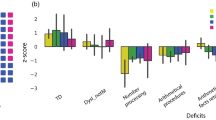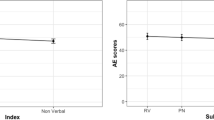Abstract
For the neuropsychological diagnosis of a Specific disorder of arithmetic skills the standard is defined worldwide by the diagnostic guidelines of the two major classification systems of psychiatric disorders, the ICD-10 and the DSM-IV, both of which use the discrepancy criterion as the key feature of the diagnosis. It becomes clear that following such guidelines can only mean an extensive diagnostic assessment of patients with subnormal arithmetic abilities, including the social and previous medical history followed by the exclusion of a present disorder or disability, often necessitating laboratory, neuroimaging and neurophysiological tests. In the neuropsychological diagnosis of a Specific disorder of arithmetical skills we found a stepwise approach including previously obtained test results to be most practical and economical. The assessment instruments such as intelligence tests, neuropsychological test batteries, academic achievement tests, specific neuropsychological tests, test batteries for arithmetic abilities or error analysis are discussed. An overview of case studies in the literature is given; however, the overwhelmign majority of case reports on patients with arithmetic disabilities are casuistics of adult patients with an acquired loss of arithmetic abilities. The importance of a differentiated neuropsychological diagnosis is demonstrated by four of our own cases: of borderline deficient intelligence, a combined disorder of academic skills, congenital brain dysfunction, and a specific disorder of arithmetic skills. Especially the new quality in assessing arithmetic abilities with the NUCALC battery is demonstrated; diagnostic and therapeutic consequences are discussed.
Similar content being viewed by others
References
Achenbach TM (1991) Manual for the Child Behaviour Checklist/ 4–18 and 1991 Profile. Burlington: University of Vermont
Cattell RB (1950) Culture Fair Intelligence Test, Scale 1 (CFT-1). Champaign: IPAT
Cattell RB (1960) Culture Fair Intelligence Test, Scale 2 (CFT-2) Champaign: IPAT
Consoli S (1979) Etude des strate gies constructives secondaires aux lesions hemispherices. Neuropsychologia 17: 303–313
De Renzi E, Vignolo LA (1982) Token Test. Weinheim: Beltz
Deegener G, Dietel B, Hamster W, Koch C, Matthaei R, Nödl H, Rückert N, Stephani U, Wolf E (1997) Tübinger Luria-Christensen-Neuropsychologische Untersuchungsreihe für Kinder (TÜKI). Zweite überarbeitete Auflage. Weinheim. Beltz Test Gesellschaft
Dehaene S (1992) Varieties of numerical abilities. Cognition 44: 1–42
Dehaene S, Cohen L (1995) Towards an anatomical and functional model of number processing. Mathematical Cognition 1: 83–120
Delazer M, Benke T (1997) A rithmetic facts without meaning. Cortex 33: 697–710
Deloche G, Seron X, Baeta E, Basso A, Salinas DC, Gaillard F, Goldenberg G, Stachowiak FJ, Temple C, Tzavaras A, Vendrell J (1993) Calculation and number processing: The EC301 Assessment Battery for brain-damaged adults. In: Stachowiak F (ed) Developments in the Assessment and Rehabilitation of Brain Damaged Patients. Tübingen: Günter Narr Verlag
Diagnostic and Statistical Manual of Mental Disorders (1994) 4th Ed. (DSM-IV). Washington, DC: American Psychiatric Association
Döpfner M, Schenk K, Berner W (1994) Handbuch: Elternfragebogen über das Verhalten von Kindern und Jugendlichen. Köln: Arbeitsgruppe Kinder-, Jugend- und Familiendiagnostik
Erdin A (1989) SHERLOCK — Ein Computerprogramm für differentielle Dyskalkuliediagnosen. Unpublished dissertation of the University of Zurich, Philosophische Fakultät I
Esser G (1992) Der langfristige Verlauf von Teilleistungsschwächen. In: Steinhausen HC (Ed) Hirnfunktionsstörungen und Teilleistungsschwächen (pp 187–211). Berlin, Heidelberg, New York: Springer
Fasotti L, Eling, PATM, Bremer, JJCB (1992) The internal representation of arithmetical word problem sentences: frontal and posterior- injured patients compored. Brain and Cognition 20: 245–263
Girelli L, Delazer M (1996) Subtraction bugs in an acalculic patient. Cortex 32: 547–555
Graichen J (1979) Zum Begriff der Teilleistungsstörungen. In: Lempp R (Ed) Teilleistungsstörungen im Kindesalter. Bern, Stuttgart, Wien: Huber
Grissemann H, Weber A (1990) Grundlagen und Praxis der Dyskalkulietherapie. Bern, Göttingen, Toronto, Seattle: Huber
Grissemann H (1996) Dyskalkulie heute. Bern, Göttingen, Toronto, Seattle: Huber
Gutbrod K, Michel M (1986) Zur klinischen Validität des Token Tests bei hirngeschädigten Kindern mit und ohne Aphasie. Diagnostica 32: 118–128
Hamster W, Langner W, Mayer K (1980) Tübinger-Luria-Christensen-Neuropsychologische Untersuchungsreihe (TÜLUC). Weinheim: Beltz Test Gesellschaft
Hartje W, Dahmen W, Zeumer H (1982) Spezielle Schreib- und Rechenstörungen bei drei Patienten nach Läsion im linken parieto-okzipitalen Übergangsbereich. Der Nervenarzt 53: 159–163
Hatten ME (1993) The role of migration in central nervous system neuronal development. Current Opinion in Neurobiology 3: 38–44
Internationale Klassifikation psychischer Störungen ICD-10. Kapitel V (F). Klinischdiagnostische Leitlinien. Dilling H, Mombour W, Schmidt MH (Eds) (1991) Bern, Göttingen, Toronto: Huber
Kaufman AS, Kaufman NL (1983) Kaufman-Assessment Battery for Children (K-ABC). Circle Pines: American Guidance Service
Klauer KJ (1992) In Mathematik mehr leistungsschwache Mädchen, im Lesen und Rechtschreiben mehr leistungsschwache Jungen? Zeitschrift für Entwicklungspsychologie und Pädagogische Psychologie 24: 48–65
Kubinger KD, Wurst E (1991) A daptives Intelligenz Diagnostikum (AID). Weinheim. Beltz Test Gesellschaft
Levin HS, Scheller J, Rickard T, Grafman J, Martinkowski K, Winslow M, Mirvis S (1996) Dyscalculia and dyslexia after right hemisphere injury in infancy. Archives of Neurology 53: 88–96
Lewandowsky M, Stadelmann E (1908) Über einen bemerkenswerten Fall von Hirnbluting und über Rechenstörungen bei Herderkrankung des Gehirns. Journal für Psychologie und Neurologie 11: 249–265
Lobeck A (1987) Rechentest für die 1.-3. Klasse. Basel: Beltz Schultests für die Schweiz
Lockowandt O (1990) Frostigs Entwicklungstest der visuellen Wahrnehmung (FEW). Weinheim: Beltz-Test
Lorenz JH (1992) Anschauung und Veranschaulichungsmittel im Mathematikunterricht. Göttingen: Hogrefe
Luccelli F, De Renzi E (1993) Primary dyscalculia after a medial frontal lesion of the left hemisphere. Journal of Neurology, Neurosurgery and Psychiatry 56: 304–307
Luria AL (1970) Die höheren kortkalen Funktionen des Menschen und ihre Störungen bei örtlichen Hirnschäden. Berlin: VEB Deutscher Verlag der Wissenschaften
Lyytinen, H, Ahonen, T Räsänen, P (1994) Dyslexia and dyscalculia in children-risks. early precursors, bottlenecks and cognitive mechanisms. Acta Paedopsychiatrica 56: 179–192
Melchers P, Preu\ U (1991) K-ABC: Kaufman-Assessment Battery for Children — deutsche Fassung. Amsterdam: Swets & Zeitlinger
Mesulam M (1990) Large-scale neurocognitive networks and distributed processing for attention, language, and memory. Annuals Neurology 28: 597–613
Müller R (1991) Diagnostischer Rechtschreibtest: Leistungstest für 3. Klassen (DRT-3). Weinheim: Beltz-Test
Müller R (1983) Diagnostischer Rechtschreibtest: für 2. Klassen (DRT-2). Weinheim: Beltz
Neumärker K-J, Bzufka MW (1988) Berliner-Luria-Neuropsychologisches Verfahren für Kinder (BLN-K). Berlin: Psychodiagnostisches Zentrum der HUB
Nichelli P, Venneri A (1995) Right hemisphere developmental learning disability: a case study. Neurocase 1: 173–177
Osterrieth PA (1944) Le test de copie d’une figure complex. Archives de Psychologie 30: 206–356
Ranschburg P (1916) Die Leseschwäche (Legasthenie) und Rechenschwäche (Arithmasthenie) der Schulkinder. Berlin: Springer
Raven JC (1976) Coloured Progressive Matrices. London: Lewis
Rey A (1941) L’examen psychologique dans les cas d’ encéphalogpathie traumatique. Archives de Psychologie 28: 286–340
Remschmidt H, Schmidt MH (1994) (Hrsg) Multiaxiales Klassifikationsschema für psychische Störungen des Kindes- und Jugendalters nach ICD-10 der WHO. 3., rev. Aufl. Bern, Göttigen, Toronto, Seattle: Huber
Roether D (1983) Vorschul-Lerntest (VLT). Berlin: Psychodiagnostisches Zentrum der Humboldt-Universität
Rourke BP (1993) Arithmetic disabilities, specific and otherwise: a neuropsychological perspective. Journal of Learning Disabilities 26: 214–226
Rourke BP, Conway JA (1997) Disabilities of arithmetic and mathematical reasoning: perspectives from neurology and neuropsychology. Journal of Learning Disabilities 30: 34–46
Samstag K, Sander A, Schmidt R (1992) Diagnostischer Rechentest für 3. Klassen (DRE-3). Weinheim und Basel: Beltz
Semenza C, Miceli L, Girelli L (1997) A deficit for arithmetical procedures: lack of knowledge or lack of monitoring? Cortex 33: 483–498
Schmidtke A, Schaller S, Becker P (1980) RAVEN-Matrizen-Test (Coloured Progressive Matrices, deutsche Bearbeitung). Weinheim: Beltz Test Gesellschaft
Schweisthal B (1997) Die Leistungen von 7- bis 15-jährigen Kindern im Verbalen Lern-und Merkfähigkeits-Test (VLMT). Zeitschrift für Neuropsychologie 8: 129–136
Takayama Y, Sugishita M, Akiguchi I, Kimura J (1994) Isolated acalculia due to left parietal lesion. Archives of Neurology 51: 286–291
Tewes U (1984) Hamburg-Wechsler-Intelligenztest für Kinder, Revision 1983 (HAWIK-R). Bern und Stuttgart: Huber
Tewes U, Schallberger U, Rossmann K (2000) Hamburg-Wechsler-Intelligenztest für Kinder III (HAWIK-III). Bern, Stuttgart: Huber
Von Aster MG (1994) Developmental dyscalculia in children: review of the literature and clinical validation. Acta Paedopsychiatrica 56: 169–178
Von Aster MG, Deloche G, Gaillard F, Tièche C (1995) Die Neuropsychologische Testbatterie für Zahlenverarbeitung und Rechnen bei Kindern (ZAREKI). Zeitschrift für Kinder- und Jugendpsychiatrie (Suppl 1) 23: 203
Von Aster MG (1997) Die Störungen des Rechnens und der Zahlenverarbeitung in der kindlichen Entwicklung. Unveröffentlichte Habilitationsschrift. Universität Zürich
Waber DP, Holmes JM (1986) Assessing children’s memory productions of the Rey-Osterrieth complex figure. Journal of Clinical and Experimental Neuropsychology 8: 563–580
Wagner H-J, Born C (1994) Diagnosticum: Basisfähigkeiten im Zahlenraum 0 bis 20 (DBZ1). Weinheim: Beltz
Weiß RH (1987) Grundintelligenztest CFT 2 Skala 2. Göttingen: Hogrefe
Weiß RH, Osterland J (1980) Grundintelligenztest CFT 1 Skala 1. Braunschweig: Westermann
Winkelmann W (1975) Testbatterie zur Erfassung kognitiver Operationen (TEKO). Braunschweig: Westermann
World Health Organization (1990) ICD-10. Diagnostic Criteria for Research. Geneva: WHO/NMH/MEP 89.1 Rev 2
Zimmermann P, Fimm B (1993) Testbatterie zur Aufmerksamkeitsprüfung (TAP). Würselen: Psytest
Author information
Authors and Affiliations
Corresponding author
Rights and permissions
About this article
Cite this article
Bzufka, M.W., Hein, J. & Neumärker, K.J. Neuropsychological differentiation of subnormal arithmetic abilities in children. European Child & Adolescent Psychiatry 9 (Suppl 2), S65–S76 (2000). https://doi.org/10.1007/s007870070010
Issue Date:
DOI: https://doi.org/10.1007/s007870070010




